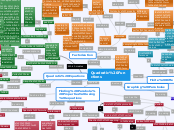Quadratic Functions
Quadratic Equations
Simplified Form
y=x^2
3 variations
Standard Form
y=ax^2+bx+c
y=x^2+3x-2
Alain throws a stone off a bridge into a river below.
The stone's height (in meters above the water), xx seconds after Alain threw it, is modeled by:
h(x)=-5x^2+10x+15
What is the height of the stone at the time it is thrown?
Vertex Form
y=a(x-h)^2+k
y=2(x+4)^2+2
y=(x-2)^2
A football is kicked into the air. Its height in meters after t seconds is given by h=-4.9(t-2.4)^2+29
What was the maximum height of the ball?
How high was the ball after 2s?Was the ball still in the air after 5s?
What was the distance of the stone after it reaches it's max height
variable h represents horizontal translations
positive
parabola moves left h amount
negative
parabola moves right h amount
variable k represents vertical translations
positive
parabola moves up k amount
negative
parabola moves down k amount
Factored Form
y=a(x-s)(x-r)
y=3(x-3)(x+2)
y=3(2x-3)(4x+4)
The company's annual profit (in millions of dollars) as a function of the app's price (in dollars) is modeled by
P=-2(x-3)(x-11)
Which app prices will result in \$0 annual profit?
Variables
Finding Parabola Properties using equations
Real Roots/x-intercepts/zeroes
Quadratic Formula
x = -b ± √b^2 - 4ac
________________
2a
solvable
answer is x-intercept(s)
used if factored form does not work
discriminant is negative number
equation has no solution
Discriminant
b^2-4ac
Nature of roots
b^2-4ac = 0
equation has 1 solution
b^2-4ac > 0
equation has 2 solutions (real roots)
A boat can cover 10 km up the stream and 5 km down the stream in 6 hours. If the speed of the stream is 1.5 km/h, find the speed of the boat in still water.
b^2-4ac < 0
equation has no solution
Perfect Square
Equation can be factorized to factored form
Factored form
(x-s) and (x-t)
(x-s)=0
X-value is the first x-intercept
If (x-s) is (x-3)
(x-3)=0
x-3=0
x=3
One x-intercept is (3,0)
(x-t)=0
X-value is the second x-intercept
If (x-t) is (2x+3)
(2x+3)=0
2x+3=0
2x=-3
x=-3/2
x=-1.5
One x-intercept is (-3/2,0) or (-1.5,0)
Vertex
Vertex Form
V(-h,k)
-h is x-coordinate of vertex
k is y-coordinate of vertex
V (-b/2a, b^2/4a - c)
-b/2a finds x-coordinate of vertex
b^2/4a - c finds y-coordinate of vertex
Roots
root(1) + root(2) /2 is x-coordinate of vertex
y-coordinate can be found
substitution
subbing x-coordinate of vertex into any quadratic equation finds y-coordinate of vertex
Axis of symmetry
x-value of vertex
Max/Min value
y-value of vertex
a value
Direction of opening
negative
parabola opens down
Reflection over x-axis
positive
parabola opens up
Vertical stretch/compression
a value is stretch/compression factor
1<a>0 or -1>a<0
vertical compression
a>1 or a<-1
vertical stretch
y-intercept
substituting x as 0 in quadratic equations
y=(x-1)^2
y=(0-1)^2
y=(-1)^2
y=1
Graphing Parabolas
Step Pattern
plot points
symmetrical curved and open plane(U-shaped)
Parabola

Base Parabola
y-intercept
Co-ordinate where parabola meets y-axis
vertex
axis of symmetry meets parabola
x co-ordinate
axis of symmetry
vertical line that divides graph into 2 equal halves
sum of the roots divided by 2
y co-ordinate
max/min value
highest/lowest point on graph
parabola opens up
minimum value
parabola opens down
Maximum value
zeroes
co-ordinate(s) where parabola meets x-axis
0,1 or 2 zeroes
plotting vertex
plot next points by moving right/left 1 and up each consecutive step pattern amount and connecting
If vertex is (0,0), and the a value is 2
the step pattern is 2,6,10...
point on graph is mirrored
plotting 2 known/solvable points on both sides of parabola
Connecting points
1a,3a,5a,7a...
Factorization
turns standard form to factored form
divide entire trinomial by common factor, monomial or binomial(if possible)
lal≠1
Find Two integers that multiply to "a(c)" and add to "b"
replace these 2 integers with b value
factor by grouping
2x^2 + 11x + 12
= 2x^2 + 8x + 3x + 12
= 2x(x + 4) + 3(x + 4)
= (2x + 3)(x + 4)
2x^2 + 8x + 3x + 12
= 2x(x + 4) + 3(x + 4)
= (2x + 3)(x + 4)
Complex Trinomial
lal=1
Find Two integers that multiply to "c" and add to "b"
These 2 numbers are the variables r and s in (x-s) and (x-r) with the original GCF being the a value
x^2 + 8x + 12
= x^2 + 6x + 2x + 12
= (x+2)(x+6)
possibly not factorizable
turn standard form to vertex form
completing the square
perfect square trinomial
the left side of standard form converts perfect square trinomial
when done, simplify to vertex form as shown
y = 2x^2 - 16x - 1
y = (2x 2 - 16x) - 1
y = 2(x 2 - 8x) - 1
y = 2(x 2 - 8x + 16 - 16) - 1
y = 2(x 2 - 8x + 16) - 16(2) - 1
y = 2(x - 4)^ 2 - 33
Formulas
difference of squares
(a + b)(a – b) = a 2 – b 2
Distributive property
a(b + c) = ab + ac
perfect square trinomial
(a±b)^2=a^2±2ab+b^2
Finite Differences
Table of values
First Differences
the subtraction of consecutive y-values
first differences are constant, there is linear relation(line)
Constant First Differences
Second differences
the subtraction of first differences
second differences are constant and not 0, there is quadratic relation(parabola)
Constant Second Differences
neither difference is constant there is no relation
